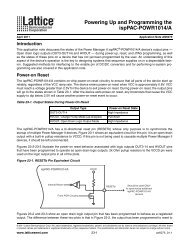Numerically Controlled Oscillator IP Core User's Guide - Lattice ...
Numerically Controlled Oscillator IP Core User's Guide - Lattice ...
Numerically Controlled Oscillator IP Core User's Guide - Lattice ...
You also want an ePaper? Increase the reach of your titles
YUMPU automatically turns print PDFs into web optimized ePapers that Google loves.
<strong>Lattice</strong> Semiconductor Functional Description<br />
Table 2-1. Interface Signal Descriptions (Continued)<br />
Port Bits I/O Description<br />
phout 3-32 O Phase output. This optional output provides the phase value corresponding to the<br />
current sine or cosine output (in unsigned format).<br />
outvalid 1 O Output valid. This optional output signal signifies the presence of a valid output at the<br />
output data busses (sine and/or cosine).<br />
Latency<br />
The latency for NCO varies depending on different parameter settings. It is displayed in the summary page of the<br />
NCO <strong>IP</strong> GUI. Latency for NCO is defined as the number of clock cycles required for changes to either fskin or<br />
pskin to be reflected in sine or cosine outputs. When both FSK input and PSK input are defined as “constant”,<br />
then the latency is the number of clock cycles for valid outputs (sine or cosine) to appear after rstn is deasserted.<br />
For the sample configuration in the timing diagram Figure 2-7, the latency is three cycles.<br />
Timing Diagrams<br />
The I/O timing diagrams for single channel and multi-channel NCOs are given in Figure 2-7 and Figure 2-8 respectively.<br />
Figure 2-7. Timing Diagram for Single Channel NCO<br />
clk<br />
rstn<br />
ce<br />
sr<br />
outvalid<br />
sine<br />
cosine<br />
00 00<br />
0f 21 33 43 52 60 6b 74<br />
00 7f 7e 7a 74 6b 60 52 43 33<br />
<strong>IP</strong>UG36_02.5, June 2010 18 NCO <strong>IP</strong> <strong>Core</strong> User’s <strong>Guide</strong>









